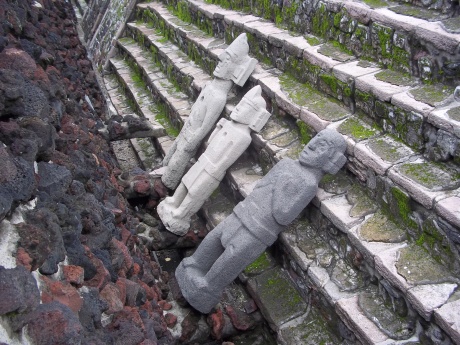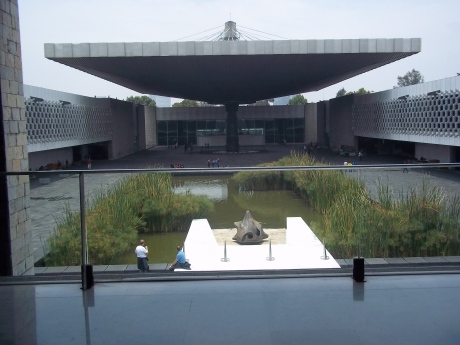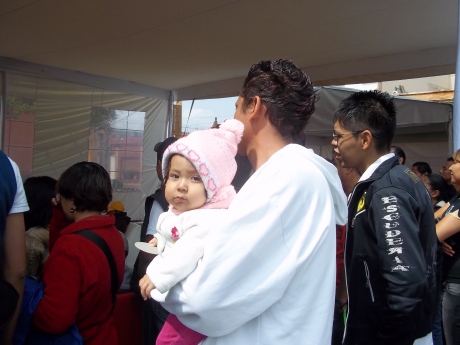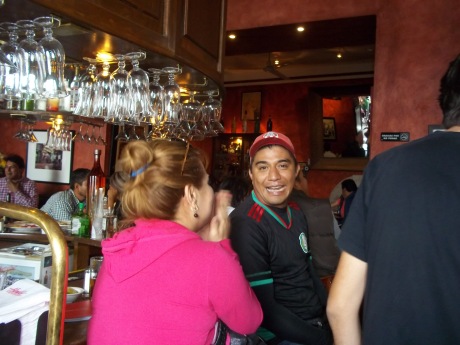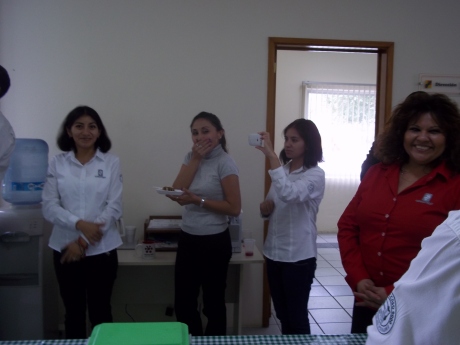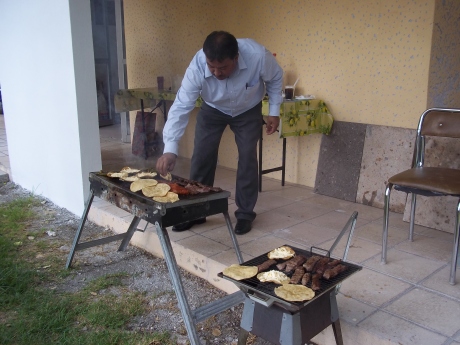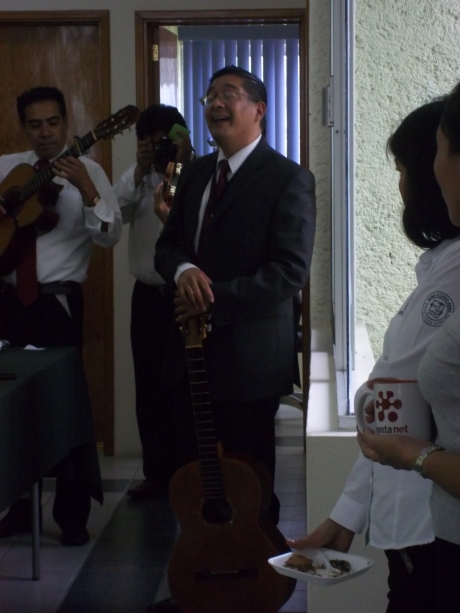I’m back in the US, but I can’t go without saying….
While in Mexico for a year, I developed an addiction that will be hard to get out of my blood, and certainly out of my heart, and that is my addiction to Mexico City. I visited five times–about a three-hour bus ride from Queretaro– and I was trying to figure out a way to get back there before I left. It did not happen. (I will just have to save up and get Aeromex from O’Hare.) And I will be back. The electricty that runs through me at the thought of this second largest city in the world will need recharging.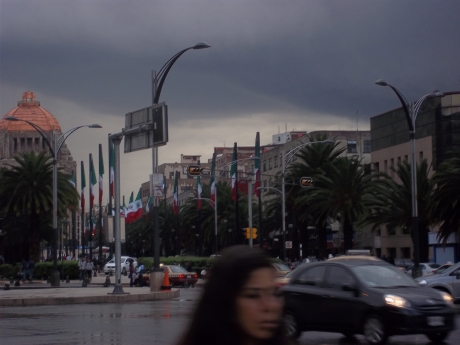
I first visited late into my PC service, and when I finally did, I followed the usual routine: Go to the main plaza and figure it out from there. I was headed to the Zocalo anyway, to the Maya exhibit at the National Palace. I had no idea what I woud see when I came out of Juarez, one of the many streets that radiate from the central plaza. The Zocalo is 10 acres, anchored by the Cathedral, the largest in the world, and it seemed that Mexico had shown up that day, or at least a good percentage of the 30 million who live there. I never saw so many people in one place at one time. A boy pulling a tarp heaped with scarves almost knocked me over. Everyone was selling something, or going somewhere. Where? Crowd-control fences help direct the hoards moving in and out of the metro stop to the dozens of neighborhoods surrounding this city on the plateau.
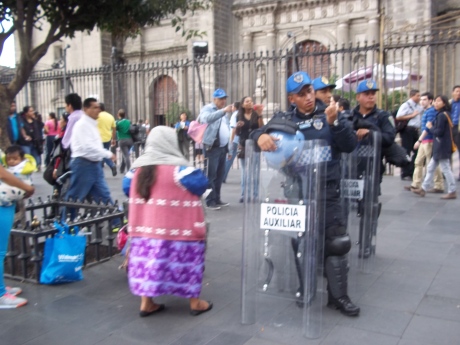
In front of the cathedral…Mexicans dressed for every occasion, in colorful indigenous skirt and vest, and bullet-proof vest
I just stood there, out of the way, gawking, which is not a good idea–especially in Mexico City. You have to look like a big-city person. But now I had seen the big-city mother of them all. I have wanted to write about it, but I feel like that little kid pouring the ocean into a hole in the sand. I’d just had to pour more and more…
The Maya exhibit, thousands of years of history written on stone, still grips me. The shophistication, the horror–the smiles and terror etched on the faces. The two laughing statues with their pets–some things do not change, even in thousands of years. I spent a whole afternoon there, after wandering into an architectural museum on Juarez where I meant to stay a minute. Right. Hours later after studying sketches, the work of Barragan and O’Gorman, the beginnings of the building of Mexico City, a city built on a Lake Texcoco that the Aztecs had accommodated with canals, boats, gardens and pyramids–which the Spanish promptly destroyed, filling in the lake, killing off the people.

The Aztec Empire–detail from Diego Rivera’s vast, fabulous murals in the National Palace on the Zocalo
When Cortes saw Tenochtitlan (Mexico City) for the first time, he reported to the king that it outrivaled Babylon and all of the greatest cities of the world. They had to have it. As if in retribution, Mexico City is sinking. I can only hope that Moctezuma is smiling somewhere.
When excating next to the Zocalo, the Mexicans unearthed one of the grandest temples to the gods ever discovered: The Templo Mayor. To walk the paths through the ruins, to see the altar of sacrifice, the black lava rocks and statues, the serpents dug up, is, in a word, thrilling.
The museum next to the dig is a treasure of pottery with painted stories, exhibits of gold, turquoise and obsidium, carved stone, including the great circle that shows the dismembered body of Coyolxauhqui. The story goes that her mother, Coatlicue, was sweeping one day when she picked up a ball of feathers, held it close to her stomach, and later was born, fully grown, Huitzilopochtli. Coyo was so jealous, she plotted to kill her mother, but the brother vowed to protect her, dismembering his sister with a fiery serpent.
On my visits to the city, I anchored each trip to one or more excursions to museums or exhibits. I saved the Anthropology Museum in Chapultepec Park until last. I took the bus down La Reforma and got off at the park–wear good shoes and rest up before the trek. It is a lovely walk along the tree lined Reforma, but you need stamina for this museum, elevated on a rise in the park with a large “shade”–a beautiful length of stone that seems suspended in the air.
The museum appears to be deceptively manageable, with two levels, one wing on each side of a courtyard, but the interior is vast, and fascinating. On one level scenes of different parts of Mexico show the cooking, the costumes, music playing (of course). One exhibit shows the history of the maguey plant that has been around for 10,000 years, its fibers, leaves, heart used for blankets, clothing, medicine, shampoo, rope, shoes–and, of course, pulque and tequila (although tequila comes from the blue agave, a sister of maguey).
While the Zocalo was the center for these visits, the thread that held it together was La Reforma, a wide–we are talking wide–boulevard modeled on the Champ d’Elysses with grand monuments marking the roundabouts. The stretch between the Zocolo and Chapultepec park is a sort of embassy row, with hotels, enormous shaded trees, plenty of space for leisurely strolling.
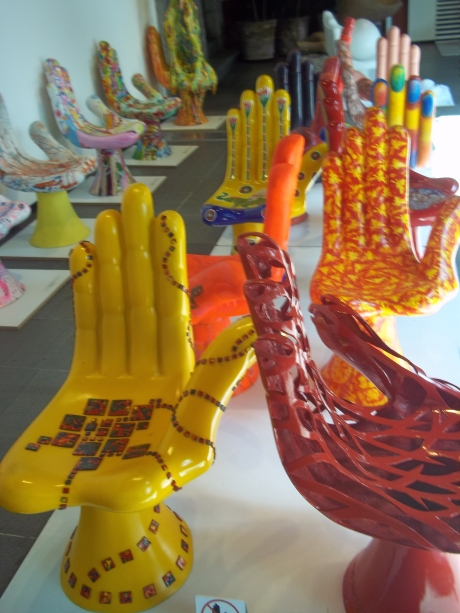
In Chicago, we have cows; at the Franz Mayer museum in Mexico City, we hands–dozens and dozens of manos with themes.
On Sundays, from 8a to 2p, the central traffic lanes from the park to the Zocalo, a distance of some six miles, are closed for bikers, skateboarders, baby carriages, all sorts of wheeled Mexicans, hoards moving at their own pace in the glorious sunshine. I thought of my cousin, Kathy, and how I have to get her down here. I did not not get a chance to ride, mostly because I did not have the time, and the traffic in Mexico City is daunting. Crossing the street on uneven pavement requires full concentration while the cars and bikes come with amazing rapidity from all directions. In the rain, it is even more terrifying.
Terrifying and surprising. Isn’t that the essence of a memorable trip? Not too much, but just enough. One thing about visiting a city this size is the number of surprises: the variety of street food, walking in off the street into a bakery that is a small village of treats, the colorful neighborhoods I barely got to visit (Coyoacan, you are next), the music at every turn–Garibaldi Plaza is dedicated to the mariachi with dozens of bands waiting for gigs, or standing around playing in the street. I may be a Chicagoan at heart, but I’m also a good bit Chilanga–a Mexico City aficionada!!
Nancy Nau Sullivan, a former English specialist in the Peace Corps in Mexico, is the author of this blog and responsible for the content.
